INTRODUCTION
Himachal Pradesh is one state that has converted itself from being the most backward state of India to one of the most advanced states in the country. Such positive growth is being able to see in this country. Furthermore, Himachal Pradesh has become an economically fourth most valuable state of India. Tourism is a very major contributor to the Himachal Pradesh economy and growth. It is also known for its best adventure tourism activities like ice skating in the Shimla area, paragliding Solang valley, rafting in Kullu, skiing in Manali, Rohtang boating in Bilaspur and trekking, horse riding and fishing in different parts in the state.
A variety of fabric is also famous in this state. Chamba rumal, thapada, etc are some type of wholesale fabrics that is being famous in Himachal Pradesh. It is not necessary to buy these fabrics from there only. There are many online wholesalers also who provide everything online. For example, there is an online company called “WholesaleBox”, it provides all kinds of clothing, fabrics, accessories at the lowest factory price. Retailers can also buy these fabrics from there. If you’re looking for affordable options for your business or personal use, you can even pay for research paper cheap on platforms that offer similar wholesale opportunities for other goods, making it easier to manage your budget while sourcing high-quality materials.
The primary source of income in this state is agriculture. Agriculture contributes 50% of the total income of Himachal Pradesh. Rice, wheat, barley, and maize are the very few types of crops that are being mainly grown in the entire state. Himachal is blessed for the fertility of the land, which is amazingly suitable for the cultivation of fruits. And also, the abundant availability of electricity has also encouraged the start of several small-scale industries in this state. Himachal Pradesh has an abundant amount of Tibetans having their home, and this is the reason that Buddhism is the next religion that is followed strongly by Hinduism. Muslims are as the very minority community in Himachal. The state also holds for 25.9 percent of the country’s total hydropower potential. As of the date March 2016, all the villages of this state have been electrified.
Due to this, a large number of craftsmen who are available and they make amazing handicrafts. This is the reason why there are many fabrics famous in Himachal Pradesh.
TEXTILES OF HIMACHAL PRADESH
Himachali styles have a specialized market as the Handcraft in Himachal are created with the unique purpose of providing the residents of the condition. Handicraft, textiles and costumes in Himachal Pradesh are also well-known with visitors. Himachal Pradesh is one of the best locations for visitors. Protected by the wonderful mountains of European Himalayas, Himachal is a gem of northern Indian. There are very few other declares in the nation that could coordinate the incredible elegance and wide range of Himachal Pradesh. This is the place, which you will like to check out again and again. As the attractiveness of the condition, the wide range of handicrafts created by the condition is also laudable. Individuals of Himachal Pradesh over the decades have designed wealthy customs of handicrafts, which are innovative and unique.
Shawls/carpets
Pashmina Shawls:
Pashmina Shawls keep individuals heated even in the very coldest of the winter seasons. These shawls are sold in various eye-catching shades and styles and are also often wonderfully stitched. The embroidering done is usually of three types–Sozni, Papier-Mache, and Aari. It usually takes four to 11 months to embroider the Pashmina Shawls which are created from the hottest and the softest wool. No wonder, these shawls often turn out to be pretty costly. To create the Pashmina Shawls glowing and eye-catching.
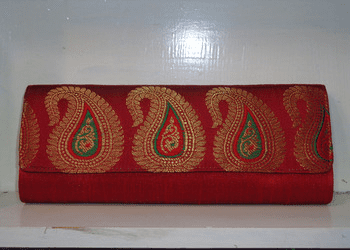
soft silk is added to the Pashmina Fiber. And the new product created from the Pashmina Made of wool, hand-loomed with soft silk, changes out to be rather resilient, strong and bright. No wonder, the Pashmina Shawls, continue to be much in requirement everywhere–from Indian to the Philippines, from People from France to Pakistan.
Lingchay
A Lingchay is a hand-woven shawl locally used as a shoulder wrap. Found in profound variety and colour, it is woven on manual looms by the rural women of mountainous Spiti in Himachal Pradesh.

Kinnauri Shawl
The main colours used for patterning are red, orange, pink, blue, green, yellow, black and white. Out of these five colours represent five elements—white stands for water, yellow for earth, red for fire, green for air and blue for ether.

Galecha
A handmade carpet in local sheep wool. The galechas tend to follow either of the following two patterns: a dragon or a set of auspicious symbols as a central motif on a plain base, or repetitions of anyone auspicious symbol running through the center with a traditional border.

Dhan
A woolen rug typically available in long and narrow shapes, for use on benches or sofas. It is usually a little thinner but also softer for seating comfort. Traditional motifs and designs in bright colours are woven into it.

Chuktu
A traditional carpet made of coarse wool of local mountain goats or of softer sheep wool. The chukthu is usually made in bright colours with multi–hued tribal motifs or geometric shapes.
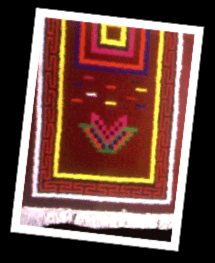
Aasan
Primarily used as seat covers, these are smaller versions of Dhans with intricate designs on the border and geometric or traditional motifs in the centre. These can also be used as floor and wall decorations.

Lokpa
A fur-lined cape, popular in Spiti.
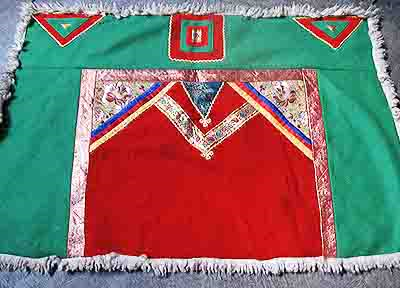
Kullu Caps
Caps, the glorious crown of Himachal Pradesh are now a recognized fashion logo in every hue. Colorful caps fascinate everyone at first instance. The traditional yet stylish headgear has derived its name from the place of its origin. Locally, it is called as Kullu topi and is an important part of a local man’s attire/apparel/garments. Alike Kullu district, in some of the other districts also, cap is an important part of male’s attire. The designs of the caps represent the area. The Kullu cap is round in shape and is flat on the top. A band of colorful border brightens the front with beautiful pattern, which is separately woven on small looms and the back portion, which covers the head is made of local woolen yarn and sometimes is also made of cotton or any other light material. These days, plain velvet caps in maroon and green colours are also available in the market. Once use of bright colours in the cap was the significant feature of the caps but nowadays, vegetable colours are being used. These caps are categorized as small, medium and large. The price of a Kullu cap depends on the cloth used and the pattern on the border.
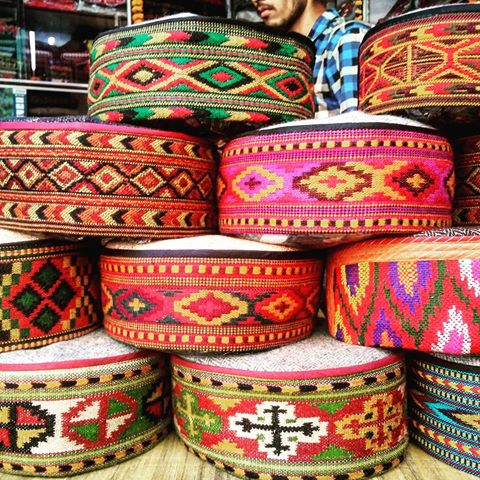
Pattoo
Pattoo is the traditional dress of local women folk of district Kullu, Manali. Kinnaur. Lahaul and Spiti. It looks like a shawl but is thicker, heavier and longer than the shawl. These pattoos are used by people to warm up bed in winter and is also worn over the clothes (suit, which consists of shirt up to knees and salwar / pyjami) by the women in the hilly and snowy area as it is a very comfortable dress, which allows them to do their daily chores besides keeping them warm.
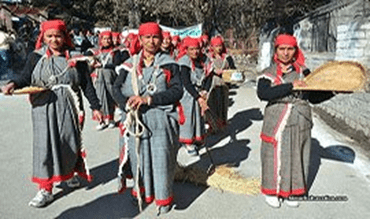
Patti
Patti is a short width coarse fabric made of sheep wool. It is woven on the handloom. Patti fabric is generally used for making close neck coats, pants, pyjamas, jackets. Initially women folk used this patti as pattoo, which was thicker and heavier than the pattoo. It is used by local people for making chola, i.e. male gown. It is made from the wool obtained from the first shearing of a lamb is used.

Thobi
Thobi is a type of floor covering, which is spun from goat hair. It is woven in 2 portions of half width and later joined from the centre with very complicated stitches. It is rough in texture, but provides warmth. Thobi is usually plain or available in checks or bands of black and gray. The size of the thobi varies from 2.15 x 0.9 m to 3.5 x 1.50 m and weighs approximately 600-800 gm. Thobis are generally woven for fulfilling personal needs; they are seldom produced for sale.
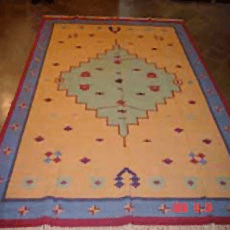
Numdha
Numdha is the local name for a mattress, which is made by felting the wool rather than weaving it. It is prepared by mixing low quality wool with a small quantity of cotton. Numdhas are usually plain or decorated with embroidered colourful designs. These mattresses come in different sizes as 1.82 x 0.91 meters or 3.65 x 3.04 meters. The price of numdhas depends on its size, quality of wool and the pattern.

Gudma
Gudma is a soft but heavy blanket, which is woven especially in the Kullu valley as this place has a special kind of clay that is used to clean and finish a Gudma. It is made of Byang wool having long fibres. Gudmas are woven in natural wool colours and finished with red or black trimmings. Size of gudmas is similar to those of numdhas. Cost of gudmas also varies according to size.

Himachal Pradesh handicrafts
The various types of handicrafts available in Himachal Pradesh consist of wood project, set embroidering, steel products, carpeting, artwork and made of wool fabrics. The wide range of handicrafts discovered in Himachal is exclusive to the condition. The styles of this condition are wide and represent the innovative expertise of the artisans.Thangka is an complex and vibrant shaded artwork done on fabric a very popular art of Tibetan artisans. These artwork mostly illustrate Buddha as well as other gods and goddess. This art is very well known especially with international tourists
Being loaded with jungles, timber is numerous in Himachal Pradesh and so woodcarving is still a living custom of the condition. Previously this art was mostly used in developing wats or temples and castles. However, at the moment artisans makes complex styles used in developing homes, and also to make other factors like low seats, rotating tires, cigarette smoking tube, cradles, low settees, containers, providing scoop, moving hooks, wood made tools, and much more. Moreover, other exciting factors like fruits containers, alcohol cups, wood made jewelry, attractive containers and designed pictures can also be discovered designed out of timber. Like most other declares in Indian, Himachal Pradesh is also loaded with conventional artwork. You can see the small artwork in art exhibits and museums in Himachal, but the real image of the conventional artwork can be seen in most town homes. The females of the home colour their surfaces. Moreover, they sketch illustrative styles known as yantras on the front door on ceremonial events. The surfaces are designed with a white-colored insert created of grain, whereas the surfaces are coloured with shades, which they gather from everyday used factors such as turmeric extract powdered, red clay-based, kumkum (a fluid used for make up) and so on. Thangkas are vibrantly shaded fabric artwork, which are mostly used as habit artwork showed during some Buddhist celebrations. Worldwide visitors love these artwork. They usually illustrate master Buddha and other deities as well as the rim of life. Carpets, Carpets are important part of providing in Himachal Pradesh. Available in amazing shades and conventional elements these products look incredibly wonderful in overall look.
Moreover, Bedding created with made of wool stiched out of lambs and goat’s are also available in a lot. Garments & Accessories used by Individuals of Himachal are very vibrant. Their conventional outfit is bedecked with sensitive embroidering with round and straight line styles. They are also attached to all types of components like vibrant neckties, bracelets, jewelry, hand knit woollen footwear, safety gloves, exhaust pipes, hats and lawn footwear.
Women in Himachal like to successfully pass their time in manufactured by working on embroidering work with hook and line. They make wonderful products of outfits like neckties, coverlets, handfans, hats, cholis (bodices), gaumukhi (prayer gloves) and so on. The highly stitched vibrant soft silk rumals (scarves) of Chamba have typically been created since the last 1000 decades. Himachali females use these small shawls as head covers. Like Kashmir, Himachal also generates excellent and valuable Shawls, which are popular by visitors from all over the world. These shawls are stiched in the bungalow sectors of Himachal and are available in simply and designed.
Cane craft
One of the finest examples of craft skills in Himachal Pradesh is its cane work. The raw material, profusely available in its lush forests, provides the industry with its strength and sustenance. The whole stem of cane and bamboo is cut with a hacksaw and split longitudinally into various sizes by a billhook.

Patari / Tokri
It is a small round woven bamboo basket with a lid and a handle for carrying it. Local people utilize it as a container to keep the chappatis, other food material or to carry fruits.

Pullas
It is a handicraft most popular in upper reaches of Inner and Outer-Seraj in the Jalori and Bashleo pass regions. Pullans are grass shoes which are used as footwear. This footwear is made out of fibers procured from the bark of a wild bush, Bhang (Cannabis sativa Linn.). The upper portion of pullan is made of goat hair and is decorated with colourful designs using threads while the bottom of footwear is made of Bang fiber. These are available in different sizes and local people consider them as warm footwear.

Costumes of Himachal Pradesh
The attire of Himachal people is very beautiful and vibrant. And it’s made according to the harsh weather conditions that linger all year round. Warm and cosy, the handwoven dresses are an attraction for people who visit the state from other parts of the country and world. Right from the caps to the dresses to the footwear, most of it is weaved manually. The handloom has risen to become the cultural identity of Himachal Pradesh.
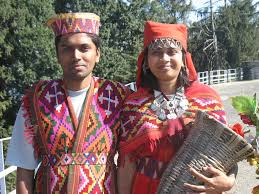
Traditional Himachal Pradesh Dresses of Men
There are mainly two classes in which the community of Himachal Pradesh has been divided: Rajput and Brahmins. The attires are largely identical, but some differences can be noted. Rajput Men wear tight Churidar Pyjamas with kurta and long silk overcoat over it. The overcoats are designed with yak leather and gold threads which help them keep warm. They wear a turban on their heads which are colour-dyed and starch-stiffened. Turbans along with moustaches are considered as a symbol of pride and honour among the Rajputs. Brahmin Men can be seen wearing dhoti and kurta along with a waistcoat or an overcoat and sometimes a turban. Priests mostly wear white clothes and a small soft towel-like cloth on their shoulders.
For occasions and festive ceremonies, men wear new kurta pyjamas along with embroidered caps or turbans and sometimes shawls.
Traditional Himachal Pradesh Dresses of Women
Rajput women wear long kurtas stretching from their neck to their toe. This began following the purdah (veil) system which is no more prevalent in the region. They also wear Ghaghris, Salwar-Kameez and Cholis. Cholis are the shirts which are worn on the upper part with a long skirt and a lot of bangles.
Brahmin women also wear similar clothing like salwar kameez and ghagra choli. For occasions and celebrations like weddings, they wear long pyjamas, traditional ghagra choli woven at homes with intricate embroidery and new rings and bangles. Footwear is designed by grass and animal skin to keep the feet warm.
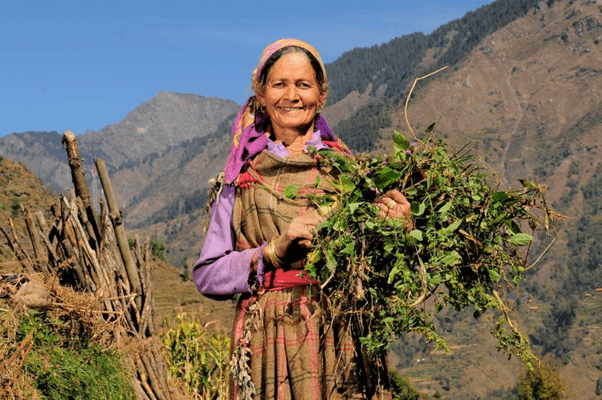
Embroidery of Himachal Pradesh
Popular for its art and embroidery, a little town called Chamba, is located in the hills of Himachal Pradesh. The small yet graceful settlement of mountain dwellers gave birth to an intricate form of needlework known as the Chamba Rumal. It is presumed that the subjects were drawn in outline by the women on the court. Chamba embroidery designs were based on nature, mythology, articles of everyday use and happenings of everyday life, animals, birds and trees etc and geometrical designs are also very popular.

History
Chamba, situated on the river Ravi, was one of the most important centers of miniature painting.The dreamlike quality of the background coupled with women of porcelain like beauty developed its own characteristics in Chamba. It is said that the King and his nobles employed the painter to record important happenings in the court including musical modes, seasons, mythological subjects, agony and love. The ladies of the court created the same motifs with their needles with an equal amount of skill of the painters.
Literally, the word ‘chamba rumal’ refers to an unconventional form of visual art achieved by beautiful embroidery created on a hand spun cloth using an untwisted silken thread which seeks its roots in pahari (mountain) paintings. Practiced in regions of Himachal Pradesh and Jammu, this intricate yet traditional form of pictorial embroidery remained the essence of pahari culture and the epitome of their tradition. The term derived from the Persian word Rumal which means a handkerchief.
Fabric and Colors
Khaddar, which is basically a rough, and hand woven cotton, and malmal, also known as fine muslin, were the fabrics used in creating Chamba rumal. The reason being that the off-white fabric creates a clear base for the embroidery while highlighting the vivid hues of the silken threads used for filling up the line art. Khaddar was used for Chamba rumal due to its availability, viable cost, and durability. The figures and floral patterns drawn on the Chamba rumals are filled with pat, a type of untwisted silken floss.
The most popular colors used in Chamba rumal are ultramarine, Persian blue, carmine, parrot green, deep red, pink, brown, black, white, lemon, deep yellow, brilliant pink, and purple.
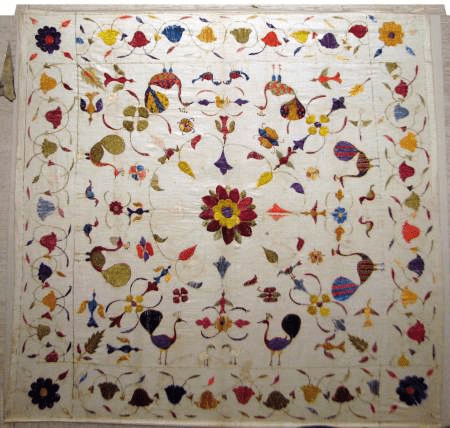
Traditions
Gifting embroidered rumals at a girl’s wedding was customary in the hills and valleys of Himachal Pradesh. The most common subjects used as inspirations for the embroidery were wedding scenes. The rumal was an essential part of the bride’s dowry who was expected to have learnt this craft at a very tender age. As it was a dowry luxury, the handicraft depended solely upon occasions such as weddings and marriages and the ceremony would not be rendered complete without the presentation of the Chamba rumal by the bride’s relatives.
Brides were considered to be all rounders if they were well trained in the craft of embroidery of the Chamba rumal. The rumals were adorned by men and women alike. People of every class produced these rumals and hung them proudly across their shoulders. Those belonging to the elite classes preferred more intricate, complex and beautiful designs.
ORNAMENTS OF HIMACHAL PRADESH
The jewellery of Himachal Pradesh is quite unique. Elliptical anklets, solid iron-headed bangles, hair ornaments, peepal-leaf-shaped forehead ornaments, and pendants with motifs of the mother goddess are some of the exquisite pieces Himachal Pradesh is famous for.
Shringar-patti is worn on forehead and it includes a fringe worn on either side of the face, consisting of a star or geometrical shaped pieces linking to each other. Hung from it are pipal leaves or stars or drops. There are also moon or crescent shaped plaques sometimes enameled, suspended on to the middle forehead.
Chudamani is a head ornament designed in lotus shape, worn by parting the hair. Kangan is a bangle which looks thin and plain in its shape, but broadens towards the two ends and is engraved into heads of tigers or elephants etc. Necklace called choker or kach is formed by many silver beads and two triangular silver plaques. Women in Gaddi district also wear a silver forehead jewelry called chiri-tikka. Chiri means bird in the local language.
An interesting ornament is worn by married women of Kinnaur. It is called khul-kantaie and consists of several, often a couple of dozen, large earrings worn hanging down from the hair over the ears mounted on a strap of cloth. Another special ornament here is digra, a decorated shawl pin consisting of a silver plaque with fine carving on it and a silver chain to connect the two opposite corners of the digra. Another amazing ornament is mulmentho, multi-joined chains with numerous pipal leaf shaped pendants.

Chandramalang is a coin necklace that is tremendously well-liked by Pahari women. Chokers called kach, made of silver beads and triangular plaques and the collar-like hansali, are quite common. All women wear heavy anklets, bangles and silver bracelets or kare, solid or filled with shellac. These are usually seen in the shape of crocodile or lions heads.
In the Tibetan influenced Lahaul-Spiti, ornaments are studded with semi-precious stones like coral, turquoise, amber and mother-of-pearl. Women of Spiti region also wear silver shawl fibula which has three circular forms symbolizing the three gems of Buddhism.

Chak ornament is worn on head. It is a silver domed top-of-head ornament which has a dozen varieties: where several round beads are hung at the edge with silver chains it is chak-boron-wala; when coloured enameling is done on it it becomes chak-meenawala; when two additional side-of-head domes are linked to the main chak it is chak-phul. This ornament is normally isn’t visible as it is covered by a head cloth.
Most of the older designs are no longer seen in today’s world but can be seen in museums like the Kangra Art Museum in Dharamsala, the State Museum in Shimla and the Bhuri Singh Museum in Chamba.
Tribes of Himachal Pradesh

The main tribe of Himachal Pradesh is the Gaddis. They also dwell in the state of Jammu and Kashmir and belong to various castes such as Rajputs, Brahmins, Thakur, Rana and Dhangar/Gaderiya. They are shepherds by profession and thus have to bear the full brunt of the harsh weather conditions. To protect themselves from the weather, they wear special coats known as Cholas. The Cholas are woven from special handspun variety of wools. The Cholas are tightened around the waist area with the help of a waistband also known as Dor. The Dor is usually made of sheep wool and are sometimes 60m in length. The portion above the Dor is loose and is used by the shepherd to stow stuffs such as lambs. The legs are covered with Pajamas made from Patti material, also known as Unali Suthan.
The Gaddis also wear a special type of headgear known as Topi, which are made from sheep wool, with a peak like projection and flaps on the sides. The projection represents the Mount Kailash and the flaps protect the ears of the shepherds during the harsh climatic conditions. The front of the cap is adorned with dried flowers, decorative beads and bird feathers. The Gaddis also sport a special type of leather show, known as Mocharu. They are very heavily built and thus correspond to durability and longevity.
During marriages and other festive occasions, the Gaddis wear cotton frocks which are red or maroon colored. The frocks are further decorated with frills, mirrors and pippins and are popularly known as Luancha or Kadds. They are tied around the waist area with yellow or white cotton strands, known as Patlka. Maroon or red colored shawl is worn over the frock and an intricate Sehra or veiled headgear is also worn as per customs.

The Gaddi women wear Luanchari with Dor and accompanied with long Dupattas. The Luancharis are very elaborate in make and requires around 20 meters of fabric. The Dors are usually black colored and it also serves the purpose of carrying loads on the back. The Luanchari of the young girls are more brightly colored. During the winter season, the women also wear white colored woolen Cholas, to escape the harsh weather.
ART AND CULTURE
The people of Himachal Pradesh are extremely hard working and talented and this reflects in their art and craft. The extremely beautiful handicraft that come out of this state is really worth appreciating. Carpets, leather works, shawls, paintings, metalware, woodwork and paintings are just some of the craft forms of the people here. The much in demand Pashmina shawl is the product of this state. Colourful Himachali caps are yet another famous art work of the people. A tribe by the name of Dom is expert in manufacturing bamboo items like boxes, sofas, chairs, baskets and rack. Clay pots and statuettes are also famous and make for a good buy. Metalware of the state include utensils, ritualistic vessels, idols, gold and silver jewelleries.
Music and Dance

Music and dance in Himachal Pradesh revolves around religion. Through their dance and music, people entreat gods during festivals and other special occasions. There are also dances that are specific to certain regions and are best performed by the people of that area.
Some of the dance forms of Himachal are Losar Shona Chuksam (Kinnaur), Dangi (Chamba), Gee Dance and Burah dance, (Sirmour), Naati, Kharait, Ujagjama and Chadhgebrikar (Kullu) and Shunto (Lahaul & Spiti).
As for the music of Himachal Pradesh is concerned, there is no classical form though there plenty of folk music to listen to. The folk stories of mountainous regions often find a mention in these music. The stories range from romance, chivalry and changing seasons. Musical instruments that are quiet frequently used by the artists here Ranasingha, Karna, Turhi, Flute, Ektara, Kindari, Jhanjh, Manjara, Chimta, Ghariyal, and Ghunghru.
Fairs & Festivals

Apart from the festivals that are celebrated on an all India basis, there are numerous other fairs and festivals that are the high point of Himachal Pradesh. These festivals are time when the religious and cultural faith of the people can be seen and felt clearly. These festivals are also the time for them to adorn colourful dress and accessories and mingle with the rest of their kins freely. Amongst these fairs and festivals are the Kullu Dussehra, Shivratri Fair (Mandi), Minjar Fair (Chamba), Mani Mahesh Chhari Yatra (Chamba), Renuka fair (Sirmaur), Lavi Trade Fair (Rampur), Vrajeshwari fair (Kangra), Jwalamukhi Fair (Jwalamukhi), Holi Fair (Sujanpur), Shivratri Fair (Mandi) and Naina Devi Fair (Bilaspur).
Cuisine
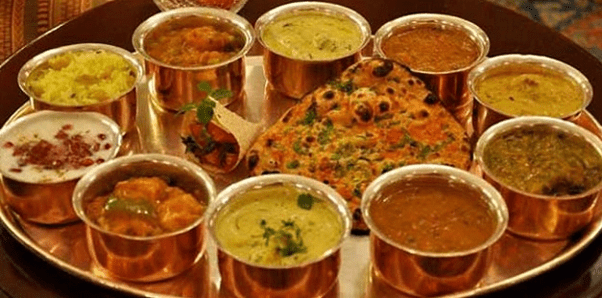
The day to day dishes of the people of Himachal Pradesh is very similar to the rest of north India in the sense that they too have dal-chawal-subzi-roti (lentil broth, rice, dish of vegetables and bread). However, one difference is that non vegetarian items are more in famous here than other north Indian states. Till recently, all that Himachal knew of vegetables were potatoes and turnips. However, now gradually, green vegetables are making their importance felt more and more. Some of the dishes that are unique to Himachal include Pateer, Chouck, Bhagjery and chutney of Til. Apart from these Nasasta is a sweetmeat of the Kangra region, Indra is dish prepared of Urad dal and Bada/Poldu is cooked in the Shimla region.
Tourism guide:- https://himachaltourism.gov.in/
The article was written by – Ms. Ayman Satopay. B.Sc in Textile and Apparel Design from Sir Vithaldas Thackersey College Of Home Science. Textile Value Chain intern. Email: tvcmedia.digital@gmail.com
